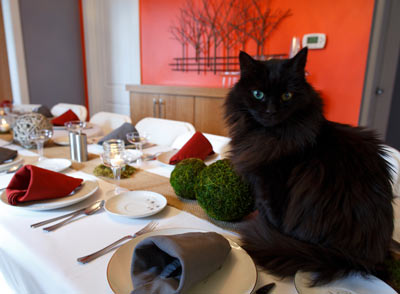How to Use Clicker Training to Keep Your Cat off the Counter

Many cats love to get up on counters and tables, checking out what's up there, licking off plates, and maybe knocking something over.
This behavior can be unsanitary for you because your cat's feet might have bits of litter and litter box contents on them, and it can also be unsafe for your cat. Jumping up onto a hot stove, for instance, can cause serious paw burns, cats can start fires by jumping up there, and they might encounter and eat toxic foods or plants.
Why Do Cats Like to Jump on Counters?
There are a few reasons that cats like to jump on counters.
- Many cats love to be high. They may feel more secure being above things, where they feel that they can watch what's going on from a safe distance.
- Cats also love to play, and they may think, rightly, that humans leave the most interesting things on counters and tables rather than the boring floor.
- Counters and tables might provide your cat with views out the window. Cats love to look outside and see birds, squirrels, and people passing by.
- Cats love to hang out with their humans and find out what they're up to. Humans spend a lot of time doing things on counters and tables.
How Can You Keep Your Cat off the Counters and Tables?
First, you'll need to provide alternatives for some of the benefits listed above that your cat might be getting from jumping up.
- Be sure you have high areas that your cat can get to and hang out.
- Make your cat some spots from which he can look out windows. You may throw a blanket on the back of the sofa, clear off some window sills, and place tall cat trees in front of windows.
- Encourage your cat to use these new spots by using treats and playing with him with a wand toy on or near them.
If your cat loves to jump on the kitchen counters while you're working there, provide him with an alternative way to hang out with you while you work in the kitchen. Give him a sturdy stool or chair from which he can see what you're doing. It can help to give him some food before you work in the kitchen, so his belly is full, and he's ready to rest and chill out.
Be sure that you're always keeping food on the counters covered or put away, to decrease temptation for your cat when you aren't around.
How to Incorporate Clicker Training into Deterring Your Cat from Jumping on Counters
Clicker training can be an effective way to teach cats new things. You'll need to get your cat accustomed to what the clicker means first, which is that the kitty is performing a behavior that you like. It won't take long before you have established in your kitty's mind that the click means he gets a treat. You can learn how to introduce this to your cat here: "Clicker Training for Cats: An Overview."
Never use physical punishment when your cat jumps on the counter and table. Doing so can stress your cat out, result in more unwanted behavior, and damage your relationship with him.
Now that your kitty knows what the clicker means, you can use it to help you keep your cat off the counter by clicking and giving a treat every time you see him on acceptable tall surfaces instead. If he's on his cat tree, click and give a treat.
If your cat is ignoring the alternative tall spots you've given him, you need to make them even more attractive.
- Add a cozy cat bed to the cat tree.
- Put a bird feeder right outside the window where you've made a spot for him on the sill.
- Clutter up the counters with things like mats covered with Sticky Paws and X-Mats to make them unattractive.
- Use catnip, clicker training with rewards, and verbal praise to make the spots you prefer your cat to use as attractive as possible.
You May Also Like These Articles:
How Do I Get My Cat into a Carrier?
Clicker Training for Cats: Come When Called
Clicker Training for Cats: Sit
Clicker Training for Cats: An Overview
How to Train Your Cat to Walk on a Leash
Notice: Ask-a-Vet is an affiliated service for those who wish to speak with a veterinary professional about their pet's specific condition. Initially, a bot will ask questions to determine the general nature of your concern. Then, you will be transferred to a human. There is a charge for the service if you choose to connect to a veterinarian. Ask-a-Vet is not manned by the staff or owners of CatHealth.com, and the advice given should not delay or replace a visit to your veterinarian.





